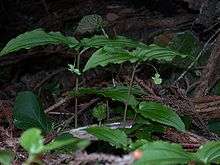Stemonaceae
The Stemonaceae are a family of monocotyledonous flowering plants placed in the order Pandanales. The family consists of four genera with ca 37 known species[2] distributed in areas with seasonal climate across Southeast Asia and tropical Australia. One native species is found in the United States. In earlier systems the family was called Roxburghiaceae, after Roxburghia, now Stemona.
| Stemonaceae | |
|---|---|
 | |
| Croomia heterosepala | |
| Scientific classification | |
| Kingdom: | Plantae |
| Clade: | Tracheophytes |
| Clade: | Angiosperms |
| Clade: | Monocots |
| Order: | Pandanales |
| Family: | Stemonaceae Caruel[1] |
| Genera | |
| Synonyms | |
| |
Description
The stems are sometimes erect or trailing with green or yellow-green color or in some cases with reddish appearance. Leaves are dark green and also alternate in the majority of the members. Flowers are born in short cymes produced from the lower parts of the plant. Seeds are ellipsoidal or globular.
As in other members of the Pandanales, the flower morphology in the Stemonaceae is distinctively developed and rather atypical for other monocots.[3] In the majority of the species, flowers are tetramerous (composed of four identical parts) or sometimes dimerous.[4] Stamens are distinguishable and four in number. In most of the members, tepals are four. They are smooth or sometimes papillate which is probably because they function as odour-producing components (osmophores). However, in Pentastemona, the flowers are pentamerous and the number of stamens is five. Microsporogenesis is successive. Reproductive structures are colored in shades of purple, maroon, green, or yellow. They imitate carrion and sometimes release such smell - flies visiting the flowers function as pollinators.
Taxonomy
The Stemonaceae, also referred to as the Roxburghiaceae, were once placed in a separate order, the Stemonales,[5] or the Dioscoreales,[6][7] sister order to the Pandanales. Also Croomia had been treated within its own family, Croomiaceae.[7]
| |||||||||||||||||||
The Stemonaceae family is sister to other two families in the Pandanales that together form a clade - these are Cyclanthaceae and Pandanaceae. Pentastemona diverged first from the family, so is a sister clade to the rest of it. Actually, the genus demonstrates characteristics rather more different from other members of the Stemonaceae.[8] In earlier classifications, it was placed in its own family. However, Stemona is sister to the other two genera that together form a clade. The family appears in Late Cretaceous - around 84 Mya, although the stem group diverged earlier in the same period - 108 Mya.[9]
Ecology
The Stemonaceae contain various herbeceous plants, many of which are crawling or climbing species preferring moist or dry tropical habitats.[10] They form underground organs as spindle-shaped rhizomes used for reservation of nutrients.
Uses
The family contains plants with various therapeutical and other uses in places such as China, Laos, Japan, Thailand, and others.[11] Some members are used for making an insecticide. In Laos, people use them against fleas and lice by making an infusion which they drink to make their blood poisonous. Plants from the family are used for the preparation of a fish poison. Others play a role in folk medicine and are valued for their antibacterial, antitussive, antifungal, and other properties against lung or skin diseases.
References
- Stevens, P. F. (2013). "Smilacaceae". Angiosperm Phylogeny Website. Retrieved 9 July 2013.
- Christenhusz, M. J. M. & Byng, J. W. (2016). "The number of known plants species in the world and its annual increase". Phytotaxa. Magnolia Press. 261 (3): 201–217. doi:10.11646/phytotaxa.261.3.1.
- https://independent.academia.edu/RichardBateman/Papers/1141756/Morphological_phylogenetic_analysis_of_Pandanales_testing_contrasting_hypotheses_of_floral_evolution
- http://delta-intkey.com/angio/www/stemonac.htm
- Huber 1969.
- Hutchinson 1959.
- Dahlgren & Clifford 1982.
- https://independent.academia.edu/RichardBateman/Papers/1141756/Morphological_phylogenetic_analysis_of_Pandanales_testing_contrasting_hypotheses_of_floral_evolution
- http://www.senckenberg.de/files/content/forschung/abteilung/botanik/phanerogamen1/janssen_janssenbremer_2004_monocotages.pdf
- "Archived copy" (PDF). Archived from the original (PDF) on 2014-12-20. Retrieved 2012-06-18.CS1 maint: archived copy as title (link)
- "Archived copy" (PDF). Archived from the original (PDF) on 2014-12-20. Retrieved 2012-06-18.CS1 maint: archived copy as title (link)
Bibliography
- Huber, H (1969). "Die Samenmerkmale und Verwandtschaftsverhältnisse der Liliifloren". Mitt. Bot. Staatssamml.[Mitteilungen der Botanischen Staatssammlung München] (in German). 8: 219–538. Retrieved 10 February 2015.CS1 maint: ref=harv (link)
- Hutchinson, John (1959) [1926–1934]. The families of flowering plants, arranged according to a new system based on their probable phylogeny. 2 vols (2nd ed.). Macmillan.CS1 maint: ref=harv (link)
- Dahlgren, Rolf; Clifford, H. T. (1982). The monocotyledons: A comparative study. London and New York: Academic Press.CS1 maint: ref=harv (link)
- Stemonaceae in L. Watson and M. J. Dallwitz (1992 onwards), The families of flowering plants
- Pentastemonaceae in L. Watson and M. J. Dallwitz (1992 onwards), The families of flowering plants
External links
| Wikimedia Commons has media related to Stemonaceae. |
| Wikispecies has information related to Stemonaceae |